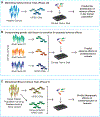Human iPSC modeling of heart disease for drug development
- PMID: 33740432
- PMCID: PMC8054828
- DOI: 10.1016/j.chembiol.2021.02.016
Human iPSC modeling of heart disease for drug development
Abstract
Human induced pluripotent stem cells (hiPSCs) have emerged as a promising platform for pharmacogenomics and drug development. In cardiology, they make it possible to produce unlimited numbers of patient-specific human cells that reproduce hallmark features of heart disease in the culture dish. Their potential applications include the discovery of mechanism-specific therapeutics, the evaluation of safety and efficacy in a human context before a drug candidate reaches patients, and the stratification of patients for clinical trials. Although this new technology has the potential to revolutionize drug discovery, translational hurdles have hindered its widespread adoption for pharmaceutical development. Here we discuss recent progress in overcoming these hurdles that should facilitate the use of hiPSCs to develop new medicines and individualize therapies for heart disease.
Keywords: HTS; cardiomyocyte; disease modeling; drug attrition; drug discovery; heart disease; hiPSC; screen.
Copyright © 2021 Elsevier Ltd. All rights reserved.
Conflict of interest statement
Declaration of interests M.M. has equity in Vala Sciences, Inc., and is on its scientific advisory board. The authors declare no other competing interests.
Figures



Similar articles
-
Will iPSC-cardiomyocytes revolutionize the discovery of drugs for heart disease?Curr Opin Pharmacol. 2018 Oct;42:55-61. doi: 10.1016/j.coph.2018.07.003. Epub 2018 Aug 3. Curr Opin Pharmacol. 2018. PMID: 30081259 Free PMC article. Review.
-
The Application of Induced Pluripotent Stem Cells in Cardiac Disease Modeling and Drug Testing.J Cardiovasc Transl Res. 2018 Oct;11(5):366-374. doi: 10.1007/s12265-018-9811-3. Epub 2018 May 29. J Cardiovasc Transl Res. 2018. PMID: 29845439 Review.
-
Human Induced Pluripotent Stem Cell as a Disease Modeling and Drug Development Platform-A Cardiac Perspective.Cells. 2021 Dec 9;10(12):3483. doi: 10.3390/cells10123483. Cells. 2021. PMID: 34943991 Free PMC article. Review.
-
Pluripotent Stem Cell-Based Platforms in Cardiac Disease Modeling and Drug Testing.Clin Pharmacol Ther. 2017 Aug;102(2):203-208. doi: 10.1002/cpt.722. Clin Pharmacol Ther. 2017. PMID: 28718902 Review.
-
High throughput physiological screening of iPSC-derived cardiomyocytes for drug development.Biochim Biophys Acta. 2016 Jul;1863(7 Pt B):1717-27. doi: 10.1016/j.bbamcr.2016.03.003. Epub 2016 Mar 4. Biochim Biophys Acta. 2016. PMID: 26952934 Free PMC article. Review.
Cited by
-
Bioengineering Strategies to Create 3D Cardiac Constructs from Human Induced Pluripotent Stem Cells.Bioengineering (Basel). 2022 Apr 10;9(4):168. doi: 10.3390/bioengineering9040168. Bioengineering (Basel). 2022. PMID: 35447728 Free PMC article. Review.
-
Harnessing developmental cues for cardiomyocyte production.Development. 2023 Aug 1;150(15):dev201483. doi: 10.1242/dev.201483. Epub 2023 Aug 10. Development. 2023. PMID: 37560977 Free PMC article. Review.
-
Creating cell-specific computational models of stem cell-derived cardiomyocytes using optical experiments.bioRxiv [Preprint]. 2024 Jan 8:2024.01.07.574577. doi: 10.1101/2024.01.07.574577. bioRxiv. 2024. Update in: PLoS Comput Biol. 2024 Sep 11;20(9):e1011806. doi: 10.1371/journal.pcbi.1011806. PMID: 38260376 Free PMC article. Updated. Preprint.
-
The grand challenge of discovering new cardiovascular drugs.Front Drug Discov (Lausanne). 2022;2:1027401. doi: 10.3389/fddsv.2022.1027401. Epub 2022 Sep 23. Front Drug Discov (Lausanne). 2022. PMID: 37123434 Free PMC article. No abstract available.
-
A deep learning platform to assess drug proarrhythmia risk.Cell Stem Cell. 2023 Jan 5;30(1):86-95.e4. doi: 10.1016/j.stem.2022.12.002. Epub 2022 Dec 22. Cell Stem Cell. 2023. PMID: 36563695 Free PMC article.
References
-
- Benjamin EJ, Muntner P, Alonso A, Bittencourt MS, Callaway CW, Carson AP, Chamberlain AM, Chang AR, Cheng S, Das SR, et al. (2019). Heart Disease and Stroke Statistics-2019 Update: A Report From the American Heart Association. Circulation 139, e56–e528. - PubMed
-
- Berridge BR, Schultze AE, Heyen JR, Searfoss GH, and Sarazan RD (2016). Technological Advances in Cardiovascular Safety Assessment Decrease Preclinical Animal Use and Improve Clinical Relevance. ILAR J 57, 120–132. - PubMed
Publication types
MeSH terms
Substances
Grants and funding
LinkOut - more resources
Full Text Sources
Other Literature Sources
Medical

